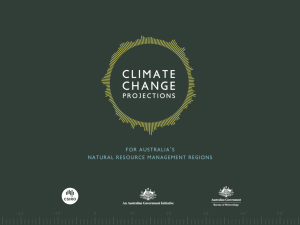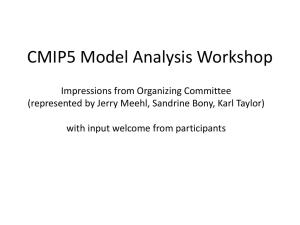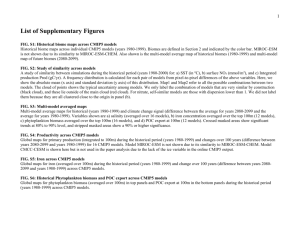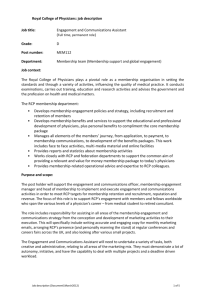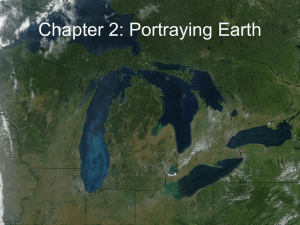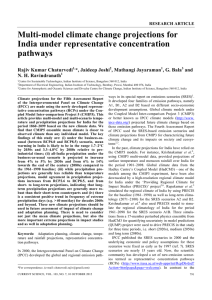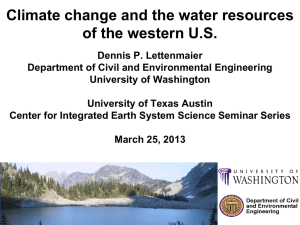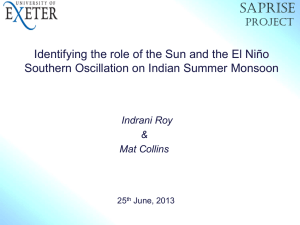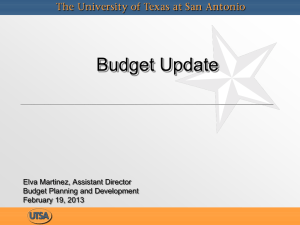CMIP5 based climate change projections for India: its
advertisement
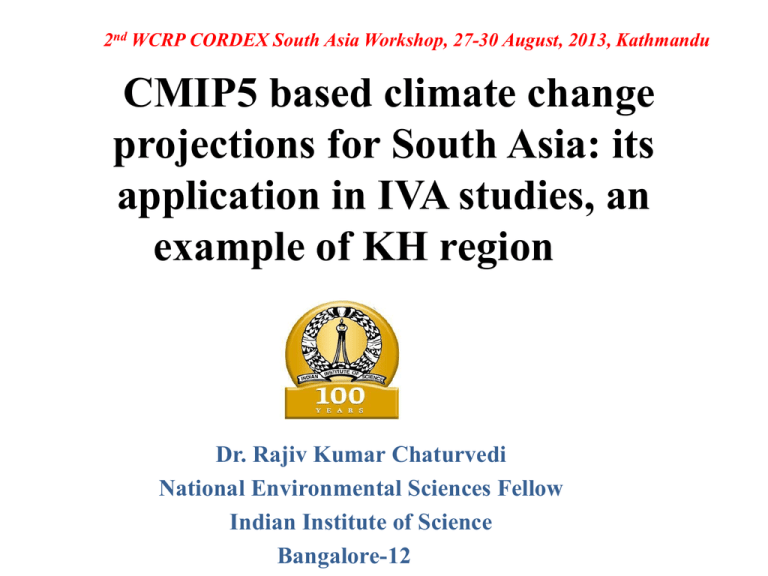
2nd WCRP CORDEX South Asia Workshop, 27-30 August, 2013, Kathmandu CMIP5 based climate change projections for South Asia: its application in IVA studies, an example of KH region Dr. Rajiv Kumar Chaturvedi National Environmental Sciences Fellow Indian Institute of Science Bangalore-12 Part 1: CMIP5 based multi-model climate change projections for India Based on Chaturvedi RK., Joshi, J., Jayaraman, M., Bala, G., Ravindranath, N.H (2012) MOTIVATION & OBJECTIVES • Availability of RCP scenarios replacing the 15 year old SRES scenarios. • By May 2012, temp and precipitation data was available from 18 CMIP5 ESMs. • CMIP5 ESMs are available on better resolution (12.8°) than the previous CMIP3 models • Goal was to have a first cut assessment of: a) reliability of CMIP5 ESMs for India, and b) uncertainty in their temperature and precipitation projections over the Indian region S. N. Model 1 2 3 4 5 6 BCC-CSM1-1-M CCSM4 CESM1(CAM5) GISS-E2-H IPSL-CM5A-MR MRI-CGCM3 1 BCC-CSM1.1 2 3 4 5 6 7 8 9 10 11 12 13 14 15 CSIRO-Mk3.6 FIO-ESM GFDL-CM3 GFDL-ESM2G GFDL-ESM2M GISS-E2-R HadGEM2-AO HadGEM2-ES IPSL-CM5A-LR MIROC5 MIROC-ESM MIROC-ESM-CHEM NorESM1-M NorESM1-ME ModelingCenter (or Group) Beijing Climate Center, China Meteorological Administration National Center for Atmospheric Research, USA Community Earth System Model Contributors NASA Goddard Institute for Space Studies, USA Institut Pierre-Simon Laplace, France Meteorological Research Institute, Japan Beijing Climate Center, China Meteorological Administration Commonwealth Scientific and Industrial Research Organization in collaboration with Queensland Climate Change Centre of Excellence, Australia The First Institute of Oceanography, SOA, China NOAA Geophysical Fluid Dynamics Laboratory NOAA Geophysical Fluid Dynamics Laboratory NOAA Geophysical Fluid Dynamics Laboratory NASA Goddard Institute for Space Studies, USA Met Office Hadley Centre, UK Met Office Hadley Centre, UK Institut Pierre-Simon Laplace, France The University of Tokyo The University of Tokyo The University of Tokyo Norwegian Climate Centre Norwegian Climate Centre lat – deg lon – deg 1.125 0.942 0.937 1.12 1.12 1.132 1.125 1.25 1.25 1.12 1.125 1.125 2.812 2.812 1.895 2.812 2 2 2 2.022 1.241 1.25 1.895 1.417 2.857 2.857 1.895 1.875 1.875 2.812 2.5 2.5 2.5 2.517 1.875 1.875 3.75 1.406 2.813 2.813 2.5 2.5 VALIDATION OF CMIP5 CLIMATE PROJECTIONS FOR INDIA (1971-2000) : A TAYLOR DIAGRAM APPROACH Can we prioritize the model for future regional downscaling based on their performance on the Taylor diagram? Chaturvedi RK., Joshi, J., Jayaraman, M., Bala, G., Ravindranath, N.H (2012) VALIDATION OF CMIP5 CLIMATE PROJECTIONS FOR INDIA Chaturvedi et al., 2012 MULTI-MODEL APPROACH TO CAPTURE UNCERTAINTIES IN TEMPERATURE AND PRECIPITATION PROJECTIONS OVER INDIA Baseline = 1961-1990 Chaturvedi et al., (2012) WHICH COULD BE THE MOST LIKELY SCENARIO? 30 GtC/Yr Fossil Fuel based emissions 25 20 15 10 5 9.5 Gt C/Yr RCP 6.0 9 RCP 4.5 8.5 RCP 2.6 2100 2090 2080 2070 2060 2050 2040 2030 2020 2010 2005 -5 2000 0 Fossil Fuel based emissions RCP 8.5 8 Actual emissions 7.5 7 6.5 2011 2010 2009 2008 2007 2006 2005 2004 2003 2002 2001 2000 WHICH COULD BE THE MOST LIKELY SCENARIO? 30 GtC/Yr 25 20 15 10 5 9.5 2100 2090 2080 2070 2060 2050 2040 2030 2020 2010 2005 -5 2000 0 Gt C/Yr RCP 6.0 9 RCP 4.5 8.5 RCP 2.6 RCP 8.5 8 Actual emissions 7.5 7 6.5 2011 2010 2009 2008 2007 2006 2005 2004 2003 2002 2001 2000 Does RCP 4.5 represent the future risks adequately? PRECIPITATION PROJECTIONS FOR INDIA AND THEIR RELIABILITY Baseline = 1961-1990 Chaturvedi et al., 2012 IPCC multi-model precipitation projections -2007 CMIP5 model ensemble based grid wise distribution of temperature and precipitation change under different RCP scenarios for India for 2080s (2070-2099) relative to pre-industrial period (1880s i.e over 1861-1900) PROJECTED CHANGE IN THE FREQUENCY OF EXTREME RAINFALL DAYS FOR FUTURE DECADES RELATIVE TO 1861-1870 BASELINE BASED ON MIROC-ESM-CHEM MODEL FOR RCP SCENARIO 4.5 Chaturvedi et al., 2012 Part 2: Application of climate data in IVA studies: An example - Impact of climate change on the glacial mass balance in Karakoram and Himalayas Based on Chaturvedi, RK., Kulkarni, A., Karyakarte, Y., Joshi, J., Bala, G (Under consideration with climatic change) STUDY AREA MOTIVATION • Bolch et al (2012) provided improved data on the hypsometry of glaciers in KH region • We wanted to apply the statistical relationship between AAR and mass balance as proposed by Kulkarni et al (2004) • Availability of somewhat improved CMIP5 projections from 21 ESMs BROAD OBJECTIVES In the light of Himalayan blunder by IPCC, we were curious to have some ‘order of magnitude’ or ‘first cut’ estimate on what happens to mass balance of KH glaciers under climate change scenarios over the 21st century THE MODEL HOW RELIABLE ARE CMIP5 ESMS FOR THE K-H REGION? RANGE OF UNCERTAINTIES IN THE TEMPERATURE AND PRECIPITATION PROJECTIONS FOR THE K-H REGION TEMPERATURE PROJECTIONS FOR HINDUKUSH AND HIMALAYA PRECIPITATION PROJECTIONS FOR HINDUKUSH AND HIMALAYA ELA PROJECTIONS UNDER RCP 8.5 MASS BALANCE CHANGE PROJECTIONS Errors bars for 2000 represent the uncertainty in current estimates; future uncertainty comes from range in temperature projections (21 models) GLACIERS AT THE RISK OF TERMINAL RETREAT RCP 8.5 scenario: Basins showing terminal retreat by 2030s are shown in blue, by 2050s in green and by 2080s in brown. CONCLUSIONS • The glacial mass loss for the entire KH region for the period 1995 to 2005 was -6.6±1 Gt yr-1 which increases by approximately six fold to -35±2 Gt yr-1 by the 2080s under the high emission scenario of RCP8.5. • However, under low emission scenario of RCP2.6 the glacial mass loss only doubles to -12 ±2 Gt yr-1 by the 2080s. • We also find that 10.6 to 27% of glaciers could face eventual disappearance by 2080s, thus underscoring the threat to water resources under high emission scenarios. UNCERTAINTIES, LIMITATIONS AND RESEARCH GAPS • High uncertainty in observed climate data • High uncertainty in projections esp. coming from GCMs as for the Hindukush and Himalaya region, resolution of climate data is crucial • Uncertainties in glaciological data Many thanks
